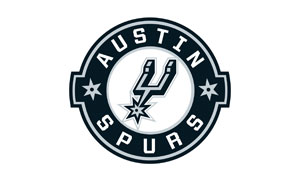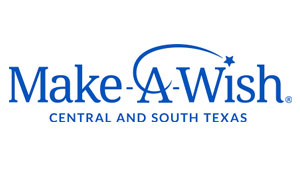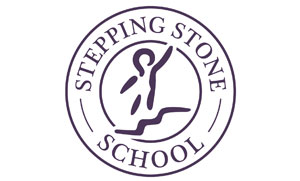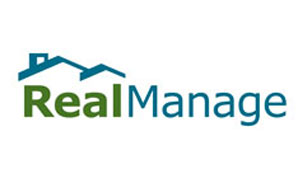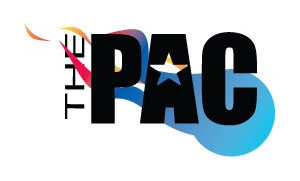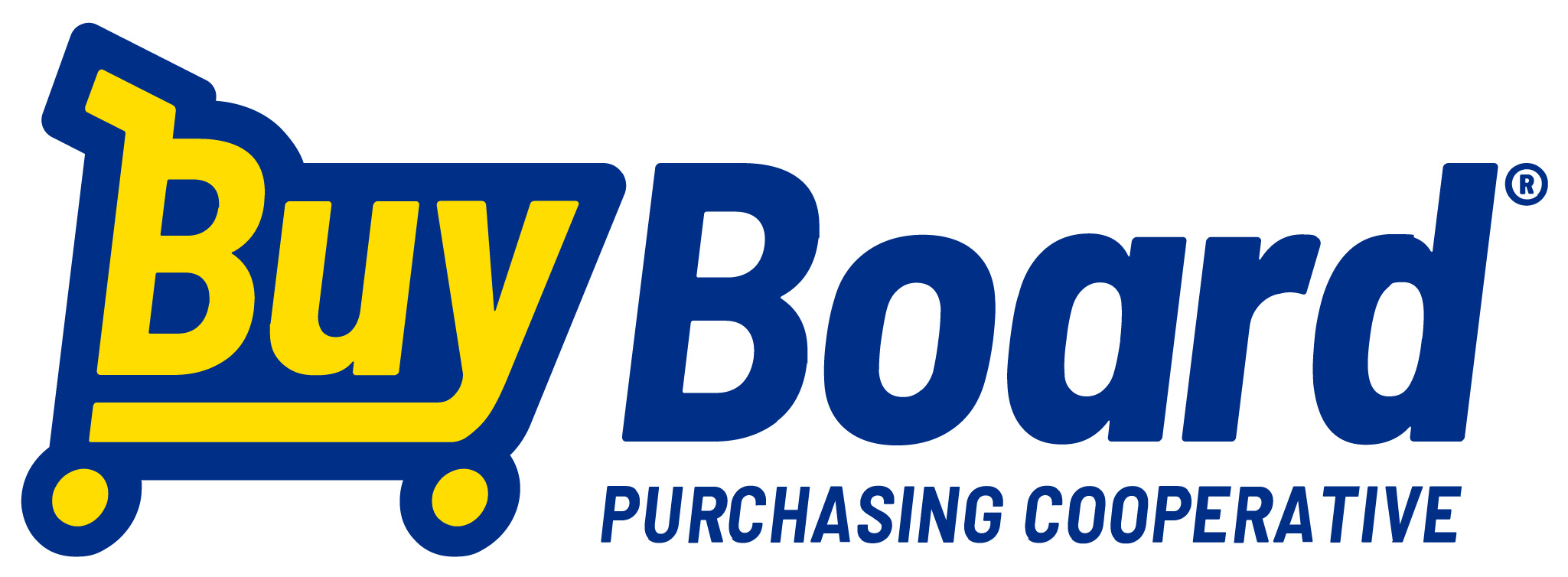Have you ever fallen on bare concrete? I bet if you did, you still remember how it felt to hit the pavement, leaving you with scaped knees, elbows or worse! Now imagine if all sports were played on concrete and nothing else. How many athletes and players of all skill levels would get injured? Sure, concrete is necessary as a base, but the flooring choice on top of it is what keeps players safe and performing well in sports like basketball, volleyball, cheerleading, tennis, and many others.
DID YOU KNOW?
Running on a hard surface can put a force up to eight times a runner’s body weight on their calf muscles, and up to fourteen times on their bones and joints.
WHEN IT COMES TO INDOOR GYM COURT FLOORING, THERE ARE FOUR MAIN CATEGORIES:
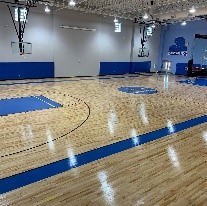
Hardwood Flooring: Hardwood flooring is the traditional choice for indoor basketball courts. When properly maintained, it offers excellent traction and stability, making it a preferred surface for basketball
l. The natural bounce of hardwood provides a classic look, and it can withstand the wear and tear of regular use. Hardwood flooring can be expensive and does require constant atmospheric controls and annual maintenance duties.
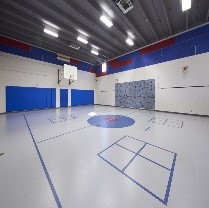
Synthetic Flooring: Synthetic rubber, rolled vinyl, or polyurethane flooring is another popular choice. It is quick to install, requires minimal maintenance, and comes in various colors and designs. Synthetic flooring, which is poured or laid over concrete, is the least expensive, but provides the least amount of protection and shock absorption of all flooring options.
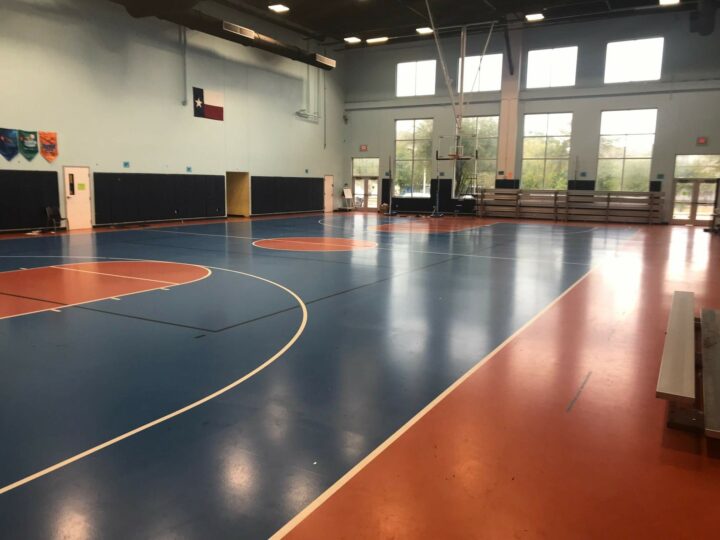
Rubber Flooring: Rubber flooring is durable and can withstand high-impact sports. It offers good traction and point shock absorption. Rubber surfacing boasts a higher safety rating than vinyl and PVC flooring. It is virtually slip-resistant, which is good and bad for those playing on the surface with regard to overall safety. Rubber flooring is a practical and a cost-effective option.
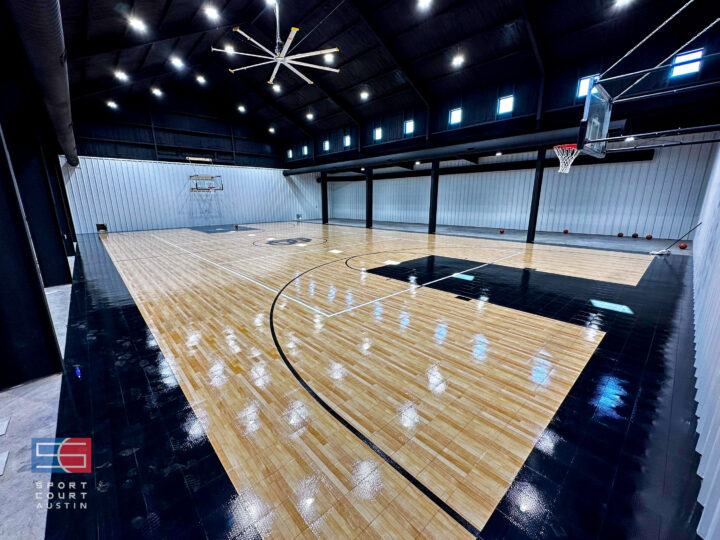
Modular Flooring: Modular Flooring is a type of surface that consists of interlocking tiles or panels and is ideal for multi-sport facilities. Many of these flooring systems combine the aesthetic appeal and look of hardwood gym flooring with superior safety features for shock absorption, reduced abrasions, and serious injuries from falls. It is the only style of gym flooring that can be lease-purchased.
While no flooring can completely prevent injuries, manufacturers are always producing new technologies to make surfaces safer and better.
This chart shows how various types of floors can be used. Of course you can deviate from these usage recommendations. But you will sacrifice performance. You may also increase injury risks and reduce the lifespan of the surface.
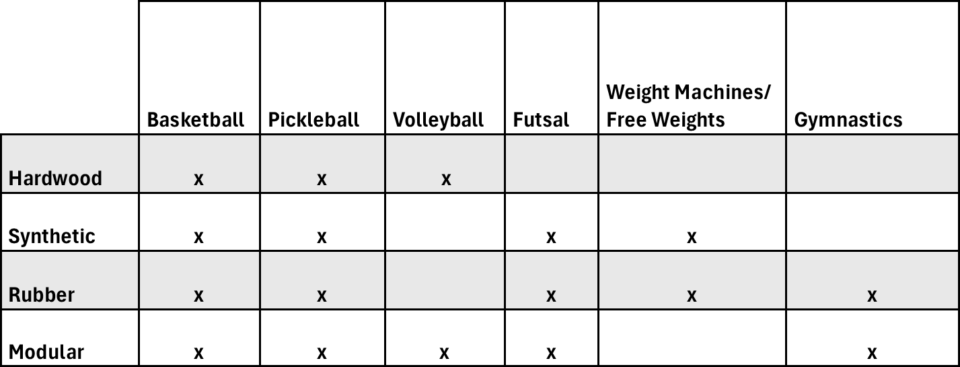
In this article, we will look at the pros and cons of two of the four flooring options, wood flooring and modular indoor flooring, covering key points like cost, installation, safety, performance, maintenance, looks, and versatility.
WHAT THE RESEARCH SAYS
Each year, more than 775,000 children, ages fourteen and younger, are treated in hospital emergency rooms for sports-related injuries. Most of these injuries occur due to falls, being struck by objects, collisions, and overexertion during unorganized or informal sports activities. While not all of these injuries happen specifically in gyms, falls are a common cause of various sports-related injuries, including:
- Concussions: A concussion is an injury to the head affecting brain function.
- High School football reports the highest incidents of injuries resulting in a concussion with over 300,000 annually.
- Girls Soccer reported the second highest among high school sports, while girls’ basketball ranked third in terms of concussion incidents.
Of the total number of high school sports related injuries reported, the following ranged from low head impacts to severe concussions and head trauma.
- 31% Cheerleading
- 28% Volleyball
- 22% Basketball
Other, less severe injuries reported included:
- Ligament Sprains, Pulled and Torn Muscles
- Bone Fractures or Dislocations
- Bruising, floor burns, abrasions, cuts, and minor lesions
According to the American Society for Testing Materials, (ASTM F2772) guidelines for sports flooring safety, standards were developed in 2009 and established the minimum criteria for indoor sports floors in North America.
The criteria for shock absorption and traction are also contributing safety factors to deciding the best surface for sports.
In a comparative study, published in the Journal of Athletic Training, of various types of floor surfaces used by cheerleaders as they relate to the potential for brain injuries; research indicates that the critical height for a wood gym floor, beyond which serious head injuries are likely, is 4.5 feet. Whereas the critical height for bare concrete and vinyl polyurethane over concrete is .5 feet.
In addition, the standard percentage of shock absorption of a gym floor should be a minimum of 10 percent, with an absorption percentage of 22% or greater for competitive sports. The higher the percentage, the higher classification is awarded to the surface. Anything under 10 percent is considered non-compliant. Although data is not as readily available for most modular court products, as it is for the traditional wood flooring. Sport Court has conducted testing on their specific indoor flooring and the results are similar to that of wood floors depending on the underlayment thickness. All levels of underlayment thickness, when topped by a Sport Court modular surface exceeded the minimum safety standards and met the ASTM F2772 Class 1 classification safety standard for indoor sports floors.
WOOD FLOORING:
Most Common Brand Names: Aacer Sports Flooring, Action Floor Systems, Connor Sports, Horner Sports Flooring, Junckers and Robbins
Pros of Wood Flooring
- Resilient & Durable under heavy use
- Optimal Shock Absorption & Safety
- Superior Ball Response
Resilient and Durable
Wood floors, predominantly made from northern-grown maple, are a traditional choice in gym flooring. Known for their flexibility and resilience, maple floors do not splinter or crack easily when cared for properly, making them durable under heavy usage, such as bleachers, concerts, and various sports activities. The thickness of a maple floor, which can separate the athlete from the concrete by up to 2.75 inches, provides significant shock absorption and safety, particularly in mitigating head impact injuries.
Optimal Shock Absorption & Safety
Wood floors are evaluated on several dynamics such as shock absorption, vertical deflection, and surface friction.
- Shock absorption is crucial as it determines how much energy the floor absorbs from the athlete, reducing the impact on their body. Wood floors, especially hard maple, offer optimal shock absorption, minimizing impact on players’ joints during intense gameplay.
- Vertical Deflection in wood gym flooring refers to the downward movement of the floor system during an athlete’s impact. When an athlete lands on the surface, the floor absorbs some of the energy from their jump. This measurement is crucial for safety and performance in sports like basketball. Excessive vertical deflection can lead to instability or reduced speed for athletes. Zero vertical is the equivalent to jumping on concrete.
- Surface friction is necessary in sports where players slide on a court. The finish on a hardwood floor plays a critical role in determining the intensity of friction a player will experience. A high gloss finish on a wood floor, which is not properly maintained and cleaned, will leave the floor slick with dust and is potentially extremely dangerous. The converse is true as well, a wood floor that is dry and over cleaned with chemicals will result in extreme traction, sticky floors and shoe grip that is also a hazard to athletes.
Superior Ball Response
The Maple Flooring Manufacturers Association (MFMA) recommends a minimum ball rebound measurement of 93 percent for basketball courts. In other words, a basketball should bounce back at least 93 percent as high as it would on concrete. A wood gym floor provides a balance between shock absorption, durability, safety, and ball response. It allows for comfortable play while supporting responsiveness for indoor recreation and sports.
Cons of Wood Flooring
- Initial Cost and Ongoing Expenses
- High Maintenance Requirements
- Temperature and Humidity Requirements
- Lack of Lateral Shock Absorption
Initial Cost and Ongoing Maintenance Expenses
-
-
- Wood flooring tends to be more expensive than other options. The initial installation cost can vary significantly based on factors such as the type of wood, substructure, and size of the facility. Installing a maple hardwood floor can cost between $15-$25/ sq. ft. Refinishing a wooden gym floor typically costs around $2 to $5 per square foot depending upon local labor rates.
- The basic ongoing cost for maintenance that ensures the floor maintains its surface color and the painted lines stay vibrant, requires that the floor be stripped and recoated every year. The cost to re-screen a floor is a minimum of $ .50 a square foot, and if the floor has high level lines and logos the cost increases exponentially. For the average sized gym, the aggregate cost to do this every year over the course of the lifetime of a court will result in maintenance expenses exceeding the original cost to install the floor.
- It is also highly recommended that the floor is sanded down to bare wood, resealed, repainted, and refinished every 7 – 10 years. The cost to do this starts at around $3.50 per square foot, again resulting in maintenance expenses over the lifetime of the floor exceeding the original cost to install the floor.
-
Maintenance and Longevity
-
-
- Wood floors require regular maintenance, including dry mopping, damp cloth cleaning, and periodic sanding and refinishing every two years. Despite the higher maintenance needs, wood floors can last as long as the gym itself if properly cared for, with an average lifespan of 38 years. Maintaining a hardwood sports floor after it is installed is also an important step in avoiding slips and falls.
-
Be prepared to take steps to maintain it properly.
- Daily dust-mopping and regular cleaning with a solution recommended by the finish manufacturer is required.
- NOTE: Never use auto scrubbers or floor cleaning machines that disperse water onto the floor, the use of scrubber machines can void the warranty on your sports floor.
- Power scrubbers were designed for other surfaces such as vct and vinyl floors. Even the softest brushes will scratch and dull the finish and can accelerate the loss of polyurethane resulting in recoating more often. The water disbursed can cause damage such as cupping and swelling if applied at too high a level.
- Beyond the daily dust mop, the floor should be screened and recoated once a year, and sanded down to bare wood, resealed, repainted, and refinished every 7 – 10 years. If this is not done, the floor surface will turn darker, and the game-line colors will not be as bright as they should be.
- Finally, a great deal of care is required to prevent the wood surface from becoming scratched or dented due to excessive heavy foot traffic or improper use. Proper protection should be used when changing gym lights, bringing in tables and chairs, rolling carts or when using the facility for other non-sport-related activities.
- NOTE: Never use auto scrubbers or floor cleaning machines that disperse water onto the floor, the use of scrubber machines can void the warranty on your sports floor.
Wood Floors are not suitable for all types of activities. Due to the high potential for pitting and scratching, as well as the poor acoustics they create, sports such as roller hockey, weightlifting, gymnastics, and sports that involve heavy impact, spiked or cleated shoes are not ideal for this surface.
Temperature & Humidity
-
-
- Wood floors are overly sensitive to extreme temperatures and the climate of the facility. To ensure optimal performance and preservation of a wood floor the temperature should be kept between 55°F – 75°F. Wood floors are also sensitive to moisture and humidity, making them susceptible to significant water damage in the event of flooding or other spilled water/liquid related incidents. Water damage is hazardous and presents itself in the form of raised, bubbled, cracked, splintered, and buckled flooring. In addition, water will stain and discolor the floor which can only be fixed with the costly resurfacing of the floor. Excessive water or constant humidity resulting in condensation can lead to the wood floor producing mold or other bacteria. When this happens the gym will smell musty and could potentially cause health related issues with those who play on its surface. Climate control is imperative to maintaining a healthy and safe surface. The humidity level should be kept between 35% – 50% to ensure minimal wood movement.
-
-
-
- Because of the climate requirements it is important to keep HVAC systems on year-round to maintain a constant temperature and humidity. Unfortunately, this requirement adds to the seasonal increases and changes in utility use and expenses.
-
Lack of Lateral Shock Absorption
The force by which an athlete changes direction or stops abruptly as it relates to the impact the movement has on their joints, knees and muscles is referred to as lateral give. Wood floors are tightly joined together and typically glued or affixed to the subfloor. This permanent adhesion prevents the floor from sliding or shifting with an athlete as they stop or slide on the floor. Although the slick finish assists with sliding, the initial impact is not absorbed causing the player’s body to absorb the full impact potentially leading to short and long-term injuries.
Modular Indoor Flooring
Most Common Brand Names: Flexcourt, Mateflex, SnapSports, Sport Court®, VersaCourt
Pros of Modular Indoor Flooring
- Initial Costs and Ongoing Expenses
- Versatility & Structure
- Safety & Performance
- Maintenance & Longevity
Modular Indoor Flooring
Modular interlocking floors are sports tiles which rest directly on the pre-existing surface, usually with a rolled rubber underlayment, without anchors or glues. Modular sport court tile floors are typically made from high-impact polypropylene-based which makes them durable and easy to clean. They are individual pieces that snap or clip together to create a continuous flooring surface.
Initial Costs and Ongoing Expenses
-
-
- The initial cost of modular tile floors for an average sized gym ranges from $8 – $14 per square foot. Costs vary based on the style or type of tile, thickness of the underlayment, number of game court lines required, the amount of pre-surface preparation required, and other construction and project specific factors. Modular tile floors are less expensive to install than most other flooring options, as they do not require environmental acclimation nor are they glued to the subfloor. Although the cost may be higher than some other synthetic floors, the removal of long-term or ongoing maintenance expenses makes up for the initial difference. In most cases, modular flooring will have the lowest life-cycle costs on any other sports floor.
-
Versatility and Customization
-
-
- Modular sports flooring offers versatility in design, surface grip, multi-use options and installation. These tiles can be installed quickly over concrete or existing flooring surfaces and are ideal for areas with high humidity and moisture problems as they are not affected by moisture or temperature fluctuations. Due to its versatility, some modular floor brands are on record as lasting over 30 years, and/or they can be taken-up, moved and reinstalled, making them ideal for temporary, pop-up courts, or rented facilities where a long-term solution is influx.
-
-
-
- Modular floors offer versatility and customization. Floors can be used for multiple sports from basketball, tennis, pickleball, volleyball and badminton, to dancing, cheer, gymnastics, futsal, football, soccer, and more. As a result of the varying degrees of underlayment the flexibility and adaptability of a modular floor makes it the perfect floor for multi-sport use. It is also highly regarded as a flooring of choice for elementary and middle school physical recreation areas where teachers and coaches have a need to design their courts around their curriculum. Due to the opportunity to change modular tiles out for other colors, designing a court that maximizes classroom instruction by using the floor as a manipulative or teaching tool supports educators in a fun and engaging way for kids.
-
-
-
- Modular floor tiles come in multiple colors and designs. Logos, game court lines, and other on court insignia are easily screened or painted on the tiles. Some modular floors offer wood grained designs to replicate the look of a traditional wood floor. With advancing technology, some manufacturers produce a high gloss, wood grain tile that are often mistaken for a wood floor because of the look, shine and ball response. Such floors maintain their shine for decades if properly cared for.
-
Safety and Performance
-
- Impact Absorption
- Modular floors are floating surfaces installed over a hard surface with a 2 mm – 7mm rolled rubber underlayment to enhance the sound of the ball bounce and add some shock absorption and comfort. Customizable with various degrees of thicknesses of underlayment, modular floors can mimic the suspended effect of wood floors, offering safety and performance tailored to specific sports. The greater the thickness of the underlayment the more cushion impact the flooring provides. Volleyball is often played on a modular surface with a 5mm to 7mm underlayment to absorb the point of contact when a player dives for a ball. For indoor sports such as basketball the underlayment ranges between 2mm and 3mm to ensure a high-quality ball response.
- Impact Absorption
-
- Lateral Force Absorption
- Most modular flooring manufacturers have patented their own terms and technology to address the need for the surface’s ability to absorb lateral forces or impacts. This flooring technology is crucial for preventing injuries during quick lateral movements, changes of direction, and sudden stops. An example of a sport and need for such a feature is Basketball. In basketball players often perform lateral movements during practice and games, such as defensive slides, quick change pivots, and jump stops. Because modular floors are floating floors and are not glued to the concrete or foundation beneath it, the small space between the tiles allows the area of impact to absorb the force generated from the sudden stop or shift in direction. Modular sports flooring provides specialized athletic surfaces with the right amount of lateral give compared to other flooring options.
- Lateral Force Absorption
-
-
- Modular tiles also feature surfaces that are designed to reduce skin abrasion due to falls. With the high gloss coating of the wood grain surfaces and the low grip surface of solid color tiles, floor burns, scrapes and bruising are minimized.
-
Maintenance and Longevity
-
-
- Modular floors are low maintenance. There will never be a need to refinish or resurface a modular floor. Regular dust mopping or a moist drag mop, such as a Court Clean® or similar system, should be used every day to clean your gym floor. This system sweeps and mops quickly and efficiently. Because this is a wet cleaning system, it is best done at the end of the day, so the floor has ample drying time. Vacuuming is important to a gym floor. The need for this will vary depending upon gym usage. If the gym is used every day, then vacuuming should be done once or twice a month depending upon weather and usage.
-
-
-
- In addition, weekly, bi-weekly, or monthly, depending upon weather and gym usage, it is recommended to use a walk behind automatic floor scrubber with a red pad. With proper care, modular floors can last up to 30 years, making them a cost-effective and low-maintenance flooring solution.
-
What if,
- You damage a tile?
- Easily remove and replace a single time or an area if needed without having to replace or remove the entire floor. The only tool needed is a 5-in-1 Painter’s Tool.
- You spill liquid or food on the floor?
- Remove the tiles in the area of the spill, dry and clean the underlayment and replace the tile.
- You experience flooding or major water damage?
- Simply, pull up the entire floor and dry or replace the underlayment and reinstall the floor. Modular Floors will not warp due to water.
- You have a power outage, and the electricity goes off in the middle of a hot summer?
- It’s ok. Modular floors are not affected by extreme temperatures. Neither heat nor cold will damage a modular floor.
Cons of Modular Indoor Flooring
- Not made for heavy rolling Loads or Pinpoint Pressure.
- Spilled liquids and food can slip between the tiles.
- The degree of complexity for a custom logo will differ by floor.
Not made for heavy rolling Loads or Pinpoint Loading.
- Modular gym flooring typically has a standard load rating of 220 psi or lower. The lower the load rating the more evenly distributed weight must be in order to avoid warping the surface. When heavy loads are not evenly distributed, such as with narrow wheels on carts, or wheels with a round profile, the load rating can be exceeded. This pinpoint loading can cause damage if not managed properly and repaired immediately. To prevent load damage, it is essential to distribute loads over a wider surface area. This principle applies to all flooring surfaces in your facility. Using wide flat wheels or pneumatic wheels on items like chair and table carts and placing plywood sheeting under larger loads such as man lifts and scissor lifts, can effectively distribute the load and protect the flooring.
Spilled liquids and food can slip between the tiles.
- Liquids such as sodas and water as well as food can slip between the tiles. Because modular surfaces are not rolled, painted, or glued together is a slight gap between the tiles. Although this gap provides the space needed for optimal shock absorption, it does pose a slight challenge when food and drinks are allowed in the gym or recreation area. When this happens, the tiles need to be extracted to clean the underlayment, then replace the tiles.
The degree of complexity for a custom logo will differ by floor.
- Indoor flooring can include custom logos and graphics. However, there are several types of indoor flooring, and some will limit the number of colors and details desired. For example, a modular floor with a high gloss finish is best for multi-color, detailed logos. Whereas, the solid, less glossy modular surfaces generally can accommodate a single color, simple logo. These differences can be seen when logos, lines and other graphics begin peeling off the floor. Painted or screened onto the tile, the number of colors, the size and the required detail of a logo or graphics design for an indoor modular court will be affected by the type of modular floor surface selected.
Conclusion
In conclusion, deciding between wood floors and modular indoor flooring hinges on several considerations, such as budget, maintenance needs, safety standards, and intended applications. Wood basketball flooring stands as the pinnacle of performance and elegance in athletic facilities. Known for its superior shock absorption, traditional wood flooring provides unmatched ball performance and safety for players, reducing the risk of injuries and enhancing overall gameplay. The natural resilience and durability of hardwood ensure long-lasting use, making it a cost-effective investment for high-traffic areas. With proper maintenance, wood basketball flooring can maintain its high-quality performance and visual appeal for decades, making it an ideal choice for any competitive sports environment.
Conversely, indoor modular flooring offers a versatile cost-effective solution for athletic and multi-purpose facilities. Engineered for durability and ease of maintenance, modular flooring provides excellent performance across a wide range of activities, from sports to community events. Its quick installation and adaptability make it ideal for spaces requiring frequent layout changes or temporary flooring solutions. Additionally, modular flooring systems are designed to offer reliable shock absorption and traction, ensuring safety and comfort for users. With a variety of styles and colors available, indoor modular flooring can also enhance the aesthetic appeal of any facility, making it a practical and attractive choice for modern indoor environments.
In the end, the decision should match the particular needs and preferences of the facility and its intended users.


